Luxury Bags on a Budget: Stylish Solutions
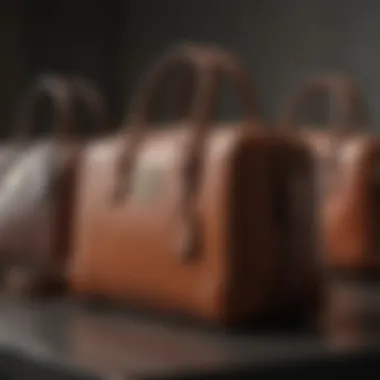
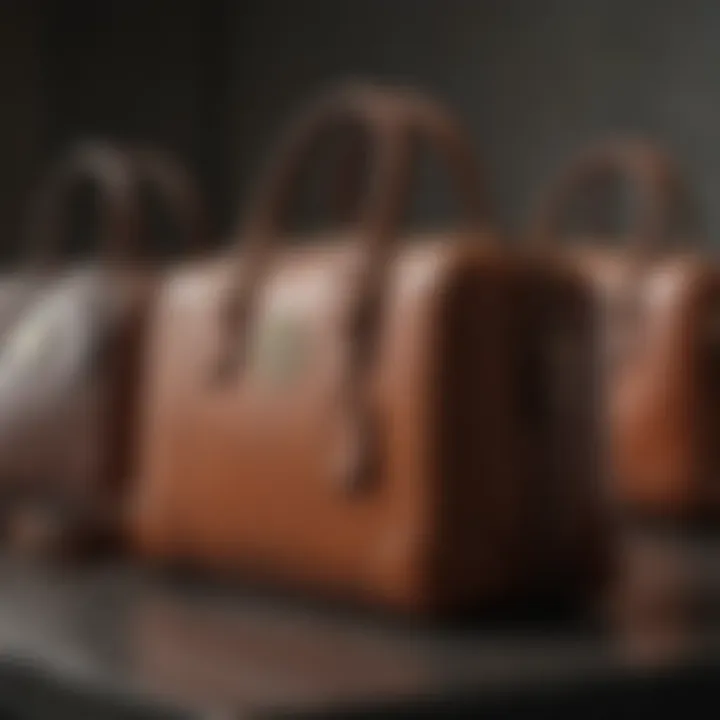
Overview of the Topic
In the current economic landscape, luxury bags represent not only a status symbol but also an element of personal style. Their allure lies deep in craftsmanship, brand heritage, and aesthetic appeal. However, the reality of their price tag is often daunting. This article investigates how to navigate the realm of high-end handbags while sticking to a tight budget.
Understanding how to acquire these coveted items without excessive spending is crucial. This involves recognizing value beyond just brand names and large price tags. The implication is twofold: it provides access to quality products while encouraging smarter financial decisions. The approach allows individuals to attain elegance in their fashion choices without compromising their financial integrity.
Key Benefits and Implications
Investing in a luxury bag on a budget opens various avenues:
- Aesthetic Value: A well-selected bag enhances any outfit, bringing an elegant touch.
- Quality Investment: Many luxury bags maintain their quality over time, serving as a long-term investment.
- Sustainable Choices: Embracing pre-owned luxury reduces waste, promoting eco-friendly practices.
The significance is clear. By adopting a strategic lens, consumers can access high-quality goods without the oppressive burden typically associated with high-end fashion.
Exploring Strategies and Tips
Practicality melds with elegance when budgeting for luxury bags. First, establish a realistic budget. This involves understanding personal finances and determining how much can be allocated for a purchase. It is wise to view luxury bags as investments rather than impulse buys.
Serching for Value
Look for sales or off-season discounts. Brands like Gucci, Prada, and Chanel occasionally have sales on older collections. Also, consider outlet stores where previous season items are offered at reduced prices.
Consider the market for pre-owned items. Websites like The RealReal or Vestiaire Collective feature authenticated luxury products at more approachable price points. They provide a pathway to access almost new condition bags, significantly less than retail.
Strategies for Effective Management
To effectively manage luxury handbag purchases, consider these steps:
- Create a Wishlist: Prioritize bags you truly desire.
- Set Alerts: Use online tools to monitor price changes on desired items.
- Engage with Communities: Follow fashion forums or subreddits about buying luxury items on a budget. Engaging with informed members can lead to valuable sharing of insights and deals.
Case Studies and Examples
In the realm of luxury bags, several individuals share successful experiences. For example, a buyer leveraged Fashionphile to find a Louis Vuitton tote significantly below retail price. With appropriate care, she maintained its condition, proving that pre-owned purchases can be both economically and aesthetically pleasing.
Pitfalls to Avoid
While seeking a luxury bag on a budget, beware of counterfeits. Always authenticate purchases. Use services that guarantee the authenticity of the item. Moreover, avoid overly aggressive spending that might introduce financial strain later.
Comparison of Financial Products
When engaging in luxury bag purchases, exploring financing options is prudent. Brands like Klarna or Afterpay offer buy-now-pay-later options to ease immediate financial pressures. However, these systems should be approached cautiously.
Pros and Cons
- Pros:
- Cons:
- Flexible payment plans decrease immediate financial burden.
- Opportunity to enjoy a luxury item without a full upfront payment.
- Risk of accumulating debt if not managed properly.
- Possible hidden fees or charges that could increase the overall expense.
Expert Insights and Recommendations
Financial experts often advise a cautious approach when indulging in luxury items. They suggest prioritizing quality over quantity—one well-chosen bag can serve a variety of occasions.
Also, nurturing an awareness of upcoming trends in sustainable luxury can provide new avenues for more cost-effective purchases. Many high-end brands are now putting effort into sustainable practices, thus creating options that are both elegant and environmentally responsible.
"Fashion is what you buy, but style is what you do with it."
- Unknown
Intro to Luxury Bags
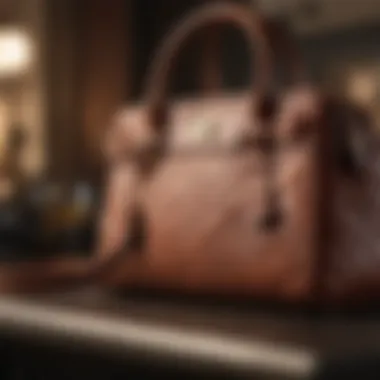
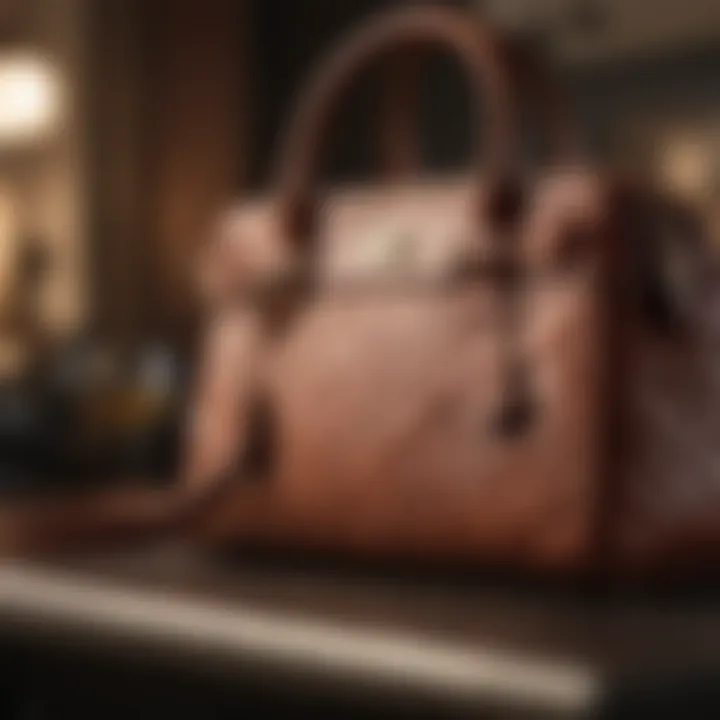
Acquiring luxury bags is more than a simple indulgence; it represents personal style, status, and sometimes even an investment. This article aims to navigate the complex world of luxury handbags while adhering to a budget. Understanding this topic is essential for aspiring buyers who wish to express elegance without overspending. The realm of luxury bags is rife with options, yet it poses challenges concerning quality, authenticity, and value. Thus, recognizing key elements allows one to make informed decisions, ensuring that one’s purchase resonates with their personal values and financial limits.
Defining Luxury in Fashion
Luxury in fashion often evokes images of high price tags, exclusivity, and high-end branding. However, it is crucial to define what luxury truly represents beyond these surface attributes. Luxury is a combination of quality materials, skilled craftsmanship, and distinctive design. It is not merely about the logo or the prestige associated with a brand, but rather about the meticulous details that go into making a handbag.
In today's market, luxury means sustainability too. Brands are increasingly focusing on ethical production methods. This adds another layer of depth to the meaning of luxury. Therefore, when one evaluates luxury items, it is vital to consider these different facets.
The Appeal of Luxury Bags
The allure of luxury bags is multifaceted. Firstly, a luxury bag often serves as a status symbol. It signals to others a certain level of success or sophistication. However, the appeal goes deeper than that. These bags are often crafted from high-grade materials that ensure longevity and durability. They often come with a promise of quality that mass-produced options cannot match.
Additionally, luxury bags offer a form of self-expression. They embody personal style and can elevate an outfit with their artistic design. Many enthusiasts view them not just as accessories but as pieces of art. The craftsmanship involved in creating a luxury bag is generally noteworthy, providing a sense of pride to the owner. In summary, while the appeal of luxury bags includes aspects of status and expression, it ultimately ties back to quality and the emotions they evoke.
"Luxury is in each detail." - Hubert de Givenchy
Recognizing these dynamics adds value to the pursuit of luxury bags on a budget. Understanding what luxury truly means enables buyers to appreciate not only the aesthetics but also the craftsmanship involved in creating these timeless pieces.
Understanding the Luxury Market
The luxury market for bags operates under specific principles that distinguish it from other fashion areas. Understanding this market is crucial for anyone aiming to acquire luxury bags without overspending. This section lays down the fundamental elements that influence what you will find in luxury offerings and how to effectively navigate them. From market trends to consumer pricing factors, an informed consumer can find higher value in their purchases.
Market Trends and Analysis
Analyzing current market trends is essential for recognizing what is genuinely high-end and what may be merely a fleeting fashion statement. Shifts in consumer behavior dictate how brands position their products. Recent years have seen a surge in interest towards sustainable luxury, where the emphasis shifts from traditional prestige to ethical production and environmental responsibility.
Trends that have emerged include:
- The rise of vintage and pre-owned items, indicating value appreciation over time.
- An increase in direct-to-consumer sales, reducing intermediary markups.
- A stronger focus on minimalism, pushing brands to create timeless designs rather than seasonal items.
Tracking these trends allows budget-conscious shoppers to capitalize on evolving market dynamics, finding luxury at a fraction of previous costs. For instance, brands like Stella McCartney have redefined luxury through sustainable practices, attracting a demographic increasingly concerned with ecological footprints.
Factors Influencing Pricing
Several factors play critical roles in determining the pricing of luxury bags. Recognizing these can help consumers make informed decisions about their purchases. Key factors include:
- Brand Reputation: Established brands like Chanel or Hermes command higher prices due to their cultural significance and history. Newer brands often provide similar quality at a lower price point while building their reputation.
- Material Quality: High-quality materials such as genuine leather, eco-friendly alternatives, or durable synthetics greatly affect costs. Understanding the material can help determine if the price reflects its true value.
- Design and Craftsmanship: Unique designs or superior craftsmanship often justify higher prices. This includes details like hand-stitching or exclusive patterns that increase desirability.
- Market Demand: Seasonal demand can cause dramatic shifts in pricing. Items that are trending may see inflated prices, while classic designs generally hold their value.
- Retailer Policies: Different retailers apply various pricing strategies based on their target demographics and sales goals.
"Understanding the elements underlying luxury pricing provides leverage in making savvy purchases that reflect true value rather than just brand prestige."
Navigating the luxury market effectively requires a blend of awareness regarding trends and insight into pricing factors. Such knowledge is invaluable when setting a budget and searching for outstanding luxury items without unnecessary spending.
Establishing a Budget
Establishing a budget is a crucial step in the journey of acquiring luxury bags without excessive spending. Many individuals desire high-end fashion, but the luxury handbag market can often be overwhelming and intimidating. A well-thought-out budget allows buyers to navigate this landscape smartly, ensuring they make purchases that align with their financial realities.
By focusing on budgetary constraints, shoppers gain clarity on what they can afford. This can prevent impulse purchases, which are common when faced with tempting options. A budget helps in prioritizing essentials over luxury, fostering a more informed purchasing mentality. Knowing your limits allows you to explore the luxury market without falling into debt or financial distress.
Additionally, a clear budget encourages mindful consumption. It prepares consumers for informed discussions about quality versus cost, ultimately leading to better buying decisions.
Assessing Financial Priorities
Assessing financial priorities is the first step in creating an effective budget for luxury purchases. It requires a careful review of one's current financial situation, consider income, expenses, and savings goals. Start by listing all monthly income sources, then outline necessary expenses such as housing, utilities, and groceries.
When evaluating these inputs:
- Identify areas where you can cut back.
- Consider your spending habits on non-essential items.
- This may include dining out, entertainment, and subscriptions.
The goal here is to create a clear picture of what portion of your income can be allocated toward luxury items like bags. By understanding this context, you can set a realistic amount that won’t disrupt essential financial obligations or create unnecessary stress.
Setting Realistic Financial Goals
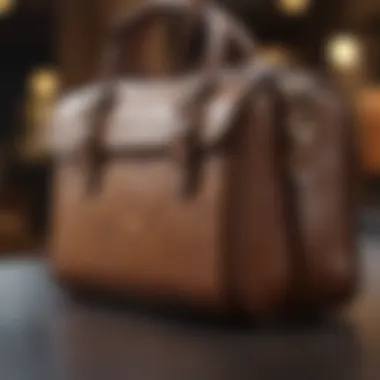
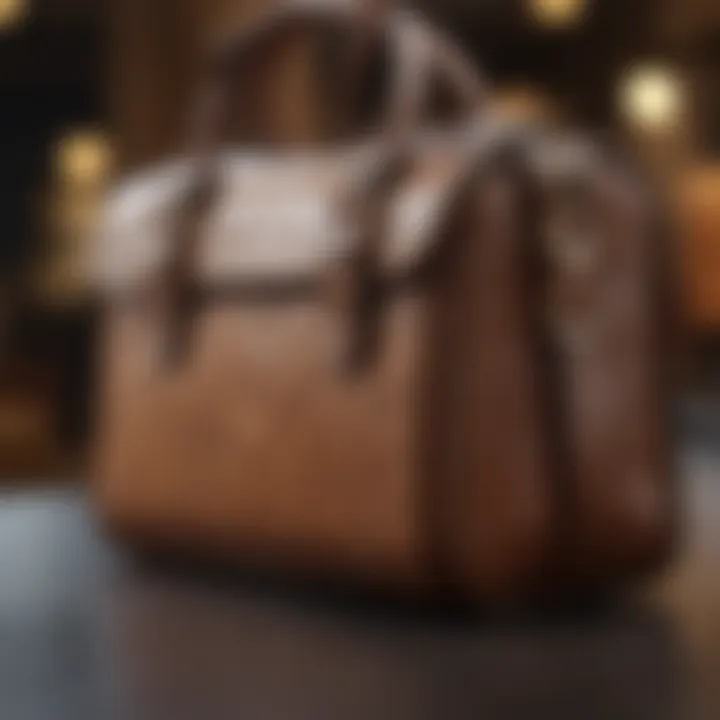
Setting realistic financial goals is paramount when trying to acquire luxury bags on a budget. It is important to determine specific targets that are both achievable and aligned with your budget assessment. Begin by deciding how often you would like to purchase new bags and the total amount you are willing to spend in a particular time frame.
Some suggestions for setting these goals might include:
- Saving a set percentage of your monthly income specifically for future luxury bag purchases.
- Creating a separate savings account designated for these purchases.
- Establishing milestone goals, such as saving a specific amount within six months.
These measures push you toward conscious spending and can make the experience of buying a luxury bag more satisfying and rewarding. Setting goals brings clarity to your spending journey and aligns with concepts of wise investment in quality items that hold their value.
Strategies for Finding Affordable Luxury Bags
Finding affordable luxury bags may seem daunting, but with the right strategies, it is entirely possible. This section will delve into effective methods for securing high-end items without straining your finances. These strategies are not just cost-saving measures but also savvy insights into the luxury market and consumer behavior. By adopting these methods, one can easily incorporate elegance into their wardrobe while maintaining financial health.
Identifying High-Quality Alternatives
When seeking affordable luxury bags, identifying high-quality alternatives is crucial. There are brands that focus on craftsmanship and materials similar to those found in luxury items but at a fraction of the cost. Look for designers like Coach or Michael Kors, who offer stylish pieces with attention to detail. Check for features such as solid stitching, durable clasps, and high-quality lining.
Understanding the materials used is also important. Look for bags made from genuine leather or sturdy synthetic materials. A well-crafted alternative can provide similar aesthetic appeal as a top-tier luxury brand.
Exploring Second-Hand Markets
Exploring second-hand markets is a practical approach to finding luxury bags at reduced prices. Websites such as Poshmark, ThredUp, or The RealReal specialize in pre-owned fashion. Used bags often come with significant savings, and many are in excellent condition.
Benefits of second-hand shopping include:
- Unique Finds: Vintage or rare styles that might no longer be in production.
- Sustainability: Contributing to a circular economy, reducing waste.
- Affordability: Accessing high-end brands without a hefty price tag.
However, verify the authenticity of each bag. Research the seller's reputation and look for signs of wear. This ensures you invest in quality without regret.
Utilizing Discount Retailers and Outlets
Discount retailers and outlet stores provide another avenue for finding luxury bags at lower prices. Retailers like Nordstrom Rack, Saks Off 5th, and Neiman Marcus Last Call often carry previous seasons’ collections. They offer brand-name items with significant discounts, making high fashion accessible.
Benefits of buying from outlets include:
- Seasonal Sales: You can find last season’s pieces for much less.
- Quality Assurance: These stores often carry products that meet high retail standards.
- Access to Exclusive Lines: Some brands create outlet-exclusive items.
Before purchasing, check the return policy to ensure satisfaction with your find.
Timing Purchases for Sales and Promotions
Timing your purchases can majorly influence your ability to buy luxury bags on a budget. Many retailers and brands hold seasonal sales, especially during holidays or change of seasons. Black Friday, Cyber Monday, and end-of-season blowouts are opportune moments to shop.
Create a shopping calendar. This helps you track upcoming sales and set reminders for significant dates. Sign up for newsletters and alerts from your favorite brands, allowing you to jump on deals when they happen.
Additionally, loyalty programs can sometimes offer exclusive discounts or early access to sales. Take advantage of these programs to maximize your savings.
By employing these strategies for finding affordable luxury bags, you can elevate your wardrobe without compromising your budget or lifestyle. Each method provides a viable path to elegance while ensuring financial stability.
Evaluating Quality in Bags
When seeking luxury bags on a budget, evaluating the quality of prospective purchases is paramount. It goes beyond mere aesthetics; the long-term value of the bag hinges largely on both material and craftsmanship. Understanding these elements facilitates informed choices, ensuring that buyers invest in items that withstand the test of time and remain stylish regardless of transient fashion trends.
Material Quality and Durability
The first aspect to consider is the material quality. High-quality materials are essential for the longevity of a luxury bag. Common premium materials include leather, suede, and high-grade synthetics. Leather, in particular, is valued for its durability and ability to age gracefully. However, not all leathers are created equal. For example, full-grain leather is regarded as the highest quality due to its unprocessed state, while bonded leather may not offer the same durability.
- Benefits of High-Quality Materials:
- Increased durability: Quality material can withstand daily wear and tear.
- Enhanced aesthetic: Well-made materials look and feel better.
- Resale value: Quality bags often retain their value over time.
Consider also the stitching of the bag. Quality stitching not only affects the bag's appearance but also its strength. Look for even stitching and reinforced seams. A lack of loose threads and proper edge finishing are also indicators of superior workmanship.
Craftsmanship and Brand Reputation
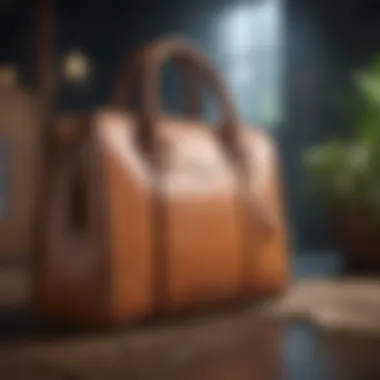

Craftsmanship reflects the skill that goes into making a bag. It encompasses aspects such as attention to detail, design integrity, and the time taken to produce each piece. Established brands often have reputations for maintaining high craftsmanship standards, making them reliable choices for consumers.
- Key Elements of Craftsmanship:
- Seam alignment: Straight and even seams speak to care during production.
- Hardware quality: Quality zippers and clasps enhance functionality.
- Interior finishing: A well-finished interior adds to the overall luxury feel.
Additionally, brand reputation plays a role in quality assurance. Renowned labels often provide insights into their production processes, offering transparency that correlates with the quality of their bags. Investing in a reputable brand can, therefore, be seen as investing in quality.
"Ultimately, the convergence of high-quality materials and skilled craftsmanship ensures that a luxury bag fulfills both functional and aesthetic desires."
Sustainable and Ethical Options
In the quest for luxury bags on a budget, two increasingly important factors stand out: sustainability and ethics. The modern consumer is more aware than ever about the impact of their purchasing decisions. They seek to align their style choices with their values. Choosing sustainable and ethical options can lead not only to a more responsible consumption approach but also to a deeper connection with the products one buys.
Understanding Sustainable Luxury
Sustainable luxury encompasses more than merely using eco-friendly materials. It involves considering the entire lifecycle of a product, from its creation to its eventual disposal. This includes sourcing raw materials responsibly, ensuring fair labor practices, and minimizing environmental impacts.
Factors that contribute to sustainable luxury include:
- Use of Organic Materials: Brands may utilize organic cotton, leather alternatives, or recycled materials. These lessen environmental damage compared to conventional counterparts.
- Transparency in Production: A commitment to transparency means brands disclose their sourcing and manufacturing processes, allowing consumers to make informed choices.
- Durability and Timeless Design: Products that are durable and stylish can be seen as sustainable investments. When a bag is of high quality, it lasts longer, reducing the need for frequent replacements.
The importance of these concepts cannot be understated. When shoppers invest in sustainable luxury bags, they often contribute to reduced waste and a healthier planet. They also promote ethical labor practices, supporting workers in different countries. By understanding sustainable luxury, one can navigate the luxury market more thoughtfully, ensuring purchases reflect personal values and environmental considerations.
Brands with a Commitment to Sustainability
Several brands are standing out for their commitment to ethical and sustainable practices. These companies are reshaping the landscape of luxury fashion. They are proving that elegance does not need to come at the expense of the environment or human rights. Key brands include:
- Stella McCartney: Known for its high commitment to vegan products and eco-friendly practices, Stella's brand ethos revolves around sustainability.
- Gucci: Although historically associated with traditional luxury, Gucci has made significant strides in recent years, implementing sustainable practices and promoting circular economy principles within its supply chain.
- Everlane: Unlike many luxury brands, Everlane focuses on radical transparency in pricing and production, ensuring that consumers know where and how products are made.
- Patagonia: Though often considered more casual, Patagonia has garnered respect for its commitment to environmental responsibility and ethical labor practices, making it an admirable choice.
Choosing brands that pledge to sustainability and ethical production helps reduce negative impacts on the environment and society. It is crucial for consumers to research and support those who are seriously working towards better futures.
By making conscious decisions, consumers empower themselves and contribute to a more sustainable fashion ecosystem.
The Role of Online Shopping
In today's digital age, online shopping has transformed the way consumers approach luxury goods. Particularly for luxury bags, the internet offers a variety of advantages that can significantly enhance the buying experience while remaining budget-conscious. Understanding the role of online shopping is essential for anyone interested in obtaining high-quality luxury bags without overspending. E-commerce platforms provide a broader selection, often at more competitive prices compared to physical retail stores.
Moreover, online shopping facilitates easy comparison of prices across various sellers. This allows consumers to find the best deals without the pressure of sales staff. The convenience of browsing at any time is also important. With just a few clicks, shoppers can sift through countless options from the comfort of their home.
Additionally, many online retailers often run promotions and discount events that may not be available in-store. Subscribers to newsletters may also gain access to exclusive deals which further enhances the cost-saving potential.
While the benefits are clear, it is vital to consider some key factors when choosing to shop online for luxury bags.
Final Considerations
In the journey of acquiring luxury bags while adhering to a budget, it is essential to incorporate final considerations to ensure long-term satisfaction and financial prudence. Understanding that luxury handbags are more than just fashion statements is vital. They represent an investment that can appreciate in value over time when chosen wisely. Assessing how these bags fit into your financial landscape can make a significant difference.
Long-term value is a crucial aspect to keep in mind. Investing in a luxury bag does not merely involve the initial purchase. The factors influencing resale value include brand reputation, market demand, rarity, and condition. Selecting bags from established luxury brands that maintain high resale value can result in a worthwhile investment. Moreover, preserving the bag in pristine condition, avoiding excessive wear, and storing it properly maximizes its longevity.
"A luxury bag can be a blend of practicality and elegance, serving as both a functional item and a collectible asset."
Furthermore, as you consider your purchases, focus on building a sustainable collection. This means curating pieces that are not just trendy but also timeless. Cultivating an understanding of sustainability in luxury fashion encourages consumers to seek out brands that prioritize ethical production methods and use eco-friendly materials. By supporting such brands, you contribute to a more sustainable fashion industry while obtaining quality items that reflect your values.
Maintaining Long-Term Value
Maintaining long-term value requires strategic approaches. First, research the bags you are interested in to understand which models have historically maintained or increased in value. Brands like Chanel and Hermès, for instance, often exhibit strong resale values because of their craftsmanship and iconic designs.
Next, consider the care of your bags. Regular cleaning, conditioned storage, and using dust bags help protect the leather and materials. If you choose pre-owned luxury bags, ensure they are authenticated and in good condition to preserve their resale value. Simple practices can enhance the longevity of your high-end purchase and help you avoid depreciation due to damage.
- Research brand trends. Some brands are seasonally more valuable.
- Keep all original packaging. It enhances resale potential.
- Consider limited editions. They typically retain value better than mass-produced items.
Building a Sustainable Collection
Building a sustainable collection is about making intentional choices. This begins with identifying eco-friendly brands that produce luxury handbags. Shifting your focus to companies like Stella McCartney or Veja can guide your decisions away from conventional leather, directing you towards more sustainable materials like recycled plastic or vegan leathers.
A sustainable collection also involves understanding the lifecycle of your bags. Prioritize high-quality items that withstand time and trends. Consider not just the initial purchase but the environmental impact as bags accumulate over years of use. Engage with the community around pre-owned handbags. Utilize platforms like Facebook or Reddit to discover the value and stories behind certain pieces.
In summary, the final considerations in acquiring luxury bags revolve around maintaining long-term value and building a collection that reflects both style and sustainability. By focusing on these aspects, you ensure that your investment is not only financially sound but also aligned with responsible consumerism.



